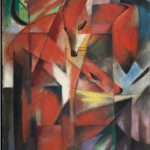
LONDON.- Sotheby’s London announced the sale of the greatest collection of 20th-Century British Art ever to come to the market: The Evill/Frost Collection, a stand-alone three-part sale which launches with an Evening Sale on Wednesday 15th. This incomparable collection comprises outstanding works of the highest calibre by Modern British masters including the most important – and largest – group of paintings by Stanley Spencer ever to come to the market, in addition to works by Lucian Freud, Henry Moore, Dame Barbara Hepworth, Graham Sutherland, Edward Burra and Patrick Heron, amongst many others. The collection – which is estimated to fetch in excess of £12 million and comprises not only 20th-century British art but also furniture and porcelain.
The paintings and sculptures, collected by Wilfrid Evill between 1925 and 1960 and then vigilantly maintained by Honor Frost, represent a window for the collectors of today to look into a past world, and the dispersal of this collection offers those same collectors opportunities that appear perhaps only once in a lifetime – to acquire the very best. The collection, aside from the Spencer’s which have been loaned for Stanley Spencer retrospectives, has been largely hidden from view since the 1965 Wilfrid Evill Memorial exhibition at Brighton City Art Gallery . The assemblage demonstrates an unparalleled vision of the achievements and talent of some of the most accomplished British artists in the period just before and after World War II.
Wilfrid Evill and Honor Frost
A discreet but widely respected connoisseur, Wilfrid Evill was a collector with a remarkable understanding of contemporary art during the inter-war period and just after. His interest in and support for British artists at this time ensured the careers of some of our most celebrated artists. Evill’s choices when he held a ten-year tenure as a buyer for the Contemporary Arts Society ensured the acquisition of masterpieces for museums and galleries throughout Britain.
Wilfrid Evill was a London solicitor who represented several artists including Stanley Spencer, Lucian Freud and Graham Sutherland – along with a number of other notable names such as Evelyn Waugh – but he also represented trade unions. It was with Stanley Spencer that Evill struck up a particularly strong friendship and he eventually built up the most important private collection of Spencer’s work. Evill’s appreciation of and support for Spencer’s work led him to acquire paintings directly after their exhibition, but he also pursued works that had been bought by other collectors, waiting a number of years until they appeared for sale on the market. Notable too are the large sums he paid for works he desired. In 1937 he paid £250 to secure Workmen in the House – a considerable amount to be spent on art at the time and significantly more money than he spent for on any other work in his collection for some years. For Lucian Freud’s Boy on a Sofa, for example, he paid just £18 in 1944, the details of which were rigorously archived in his ledgers. No other private lender, beyond the artist himself, was more generous than he, as was seen for the 1955 Tate Gallery retrospective of Spencer. Similarly, bequests by Wilfrid Evill of important Spencer paintings to the Fitzwilliam Museum in Cambridge immediately established their holding of the artist’s work as one of the most significant outside London.
When Evill died in 1963 he bequeathed his estate, together with his extraordinary collection of paintings and works of art, to his long-time ward Honor Frost. An only child, Honor lost both her parents when she was small, after which Evill took over responsibility for her upbringing and education. Both keenly intelligent, they developed over the years an extremely close relationship. A fascinating woman in her own right, Honor shared Evill’s love of the arts: having studied at the Central School of Art in London, and the Ruskin School of Art in Oxford, she went on to work as a designer for the Ballet Rambert and then became director of publications at the Tate Gallery, before becoming a marine archaeologist, for which she is renowned, pioneering its pursuit as a scientific discipline.
Stanley Spencer, R.A. (1891-1959)
The elements of narrative, personal experience and visionary presentation make Stanley Spencer one of the most important yet elusive British artists of the twentieth century, and he is represented in the Evill/Frost Collection by a group of works that offer an opportunity to rediscover and re-engage with the artist’s life and vision. Executed in 1935, Workmen in the House (est. £1.5-2.5 million**) ranks among the most important works in Stanley Spencer’s oeuvre. It has featured in virtually every publication on the artist, and indeed was chosen as the cover for the important 1955 Tate retrospective of the artist’s work, as well as for Evill’s memorial exhibition in 1965. It thus holds a position as one of the best known yet relatively little seen of Spencer’s major paintings. One of his more accessible works of this period in Spencer’s career, Workmen in the House refers to an incident at Chapel View, the house Spencer lived in whilst painting the Burghclere Chapel series. The everyday setting of a smoking kitchen range becomes a springboard for the artist which allows him to address a much wider range of topics, not least the element of intrusion and disturbance of the home environment that the visit of the workmen entails. As with much of Spencer’s best work, one detailed memory leads to a wider remembrance, and in a letter of 1937 he outlined how this derived from the sense of excitement that he had experienced as a small boy when familiar rooms were redecorated and the furniture moved around.
Not seen in public since the Wilfrid Evill Memorial Exhibition of 1965, Patrick Heron’s Table with Fishes, of 1954, is estimated at £250,000-350,000. This is a superb example of Heron’s early style, drawing on the example of Braque’s magisterial Atelier interiors, but employing a palette and manner entirely his own. The coloring of this painting is particularly striking, the blue, red and pink creating the space of the room, whilst the dense inky blackness of the night-time world beyond the window is remarkable. The thick handling of the paint offers a wonderful counterpoint to the delicacy of Heron’s line, which winds beautifully across the image, giving enough detail to inform without ever showing too much. The guttering flame of the candle is a master-stroke, animating the entire composition with just the simplest and most minimal gesture.

Spencer’s Sunflower and Dog Worship, an important work of 1937, ranks among the most extreme manifestations of Spencer’s notion of universal harmony. In it, Spencer envisages a heaven-like state of all-embracing love as the two central figures, a husband and wife enclosed within their garden walls with a number of dogs (emblematic in Spencer’s work of the kind of untrammeled freedom mankind is seeking), enjoy a mystical state of joy, embracing and being embraced by huge sunflowers. Spencer’s more complex, narrative works such as this were less readily appreciated by the wider collecting community of the time, yet Evill belonged to a small band of collectors who saw in works such as these the “real Spencer”. Sir Hugh Walpole was another collector who shared Evill’s appreciation of Spencer’s work and he was quick to recognize the importance of this painting, purchasing it within just two hours of its exhibition in December 1937. Disappointed at having missed it, Evill was able to buy it from Walpole some seven years later for £100. It is now estimated at £1,000,000-1,500,000.
Further Highlights of the Sale
Beyond the uniquely large group of works by Spencer, the sale offers paintings, drawings, watercolors and sculptures; a selection which moves through generational boundaries, and highlights different phases of Evill’s collecting. Starting with the major names of the inter-war period, such as Henry Moore, Edward Burra, and Graham Sutherland, together with Spencer, William Roberts and Paul Nash, his involvement with the Contemporary Art Society gave him access to a younger generation of artists working in the post-war period. These included the young Lucian Freud, John Craxton and Patrick Heron.
A stunning example of Lucian Freud’s early work Boy on a Sofa (est. £400,000-600,000), drawn in 1944, demonstrates the artist’s exceptional ability as a draughtsman. A composition of wonderful simplicity, the direct presentation of the sitter (Billy Lumley) and his engagement with us as a viewer is nevertheless somewhat disarming, and the setting – using the worn chaise that appears in the seminal The Painter’s Room of the same year – and the clothing appear oddly out of keeping with the youth and innocence of the sitter.

Not seen in public since the Wilfrid Evill Memorial Exhibition of 1965, Patrick Heron’s Table with Fishes, of 1954, is estimated at £250,000-350,000. This is a superb example of Heron’s early style, drawing on the example of Braque’s magisterial Atelier interiors, but employing a palette and manner entirely his own. The coloring of this painting is particularly striking, the blue, red and pink creating the space of the room, whilst the dense inky blackness of the night-time world beyond the window is remarkable. The thick handling of the paint offers a wonderful counterpoint to the delicacy of Heron’s line, which winds beautifully across the image, giving enough detail to inform without ever showing too much. The guttering flame of the candle is a master-stroke, animating the entire composition with just the simplest and most minimal gesture.
Henry Moore’s bronze, Rocking Chair No.3 was purchased by Evill in the 1950s for £150. One of an edition of 6 casts, this important piece now comes to auction with an estimate of £800,000-1,200,000. Moore’s ability to combine realism and abstraction in his sculpture works here as a perfect vehicle for a sculpture that despite its scale has both a monumentality and a real tenderness. The theme of the mother and child was a central one for Moore throughout his career and this marvelously poised sculpture captivates by its understanding of the subject and his rendering of it into sculptural forms.
A rigorously urban image of life on the streets, rife with style and shrewdly observed elements of character, Edward Burra’s Zoot Suits, £250,000-350,000, depicts a group of men newly arrived in London from Jamaica on the SS Empire Windrush in 1948, and who are establishing themselves within the new urban culture that was burgeoning in London. The work recalls Burra’s excitement on first visiting New York in 1933 when he was particularly drawn to the energy of the Harlem Renaissance and therefore draws a parallel between the artistic and social movements present in New York in the 1930s and those emerging in London in the 1940s.
Furniture & Ceramics
In addition to works of art, the sale will also include a selection of furniture and ceramics, a highlight of which is a Sèvres tea service contained within a kingwood parquetry carrying box (est. £10,000-15,000), formerly in the collection of the great actor, director and theatre manager David Garrick (1717-79). Garrick visited Paris three times and on his final visit in the autumn of 1764, returning from a European tour, he purchased this Sèvres service together with its fitted box. This illustrious owner and the high quality of the set by possibly the best 18th century porcelain manufactures would have delighted Evill and met the qualifying requirements of beauty and quality that were established for choosing objects for his collection.








